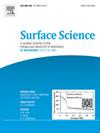环境依赖显性和亚稳态掺杂NiO(110)表面的鉴定
IF 1.8
4区 化学
Q3 CHEMISTRY, PHYSICAL
引用次数: 0
摘要
由于优异的氧化还原性能和可调的结构和电子性能,掺杂镍基表面(M-NiO)已被广泛探索用于各种催化应用。特别是,不太稳定但更活跃的NiO(110)面具有实现更高催化性能的潜力。为了便于M-NiO活性位点的设计和原位控制,对掺杂元素与环境相关的表面结构和稳定性之间的联系有一个表面水平的理解是至关重要的。本文采用结合密度泛函理论(DFT)和从头算相图的集成从头算热力学建模方法对M-NiO(110)结构进行了系统研究。考察了掺杂元素(Al、Mo、Nb、Sn、Ti、V、W或Zr)、掺杂位置(表面/亚表面)、O空位(表面/亚表面)、Ni空位(表面/亚表面)和吸附氧(O*/O2*)的影响。主要的NiO(110)结构是化学计量表面和氧吸附表面。在NiO(110)中引入掺杂剂显著增加了表面的构型复杂性。观察到M-NiO(110)和(100)面之间一致的结构稳定性-从先前的研究中获得的后一个面数据-使两个面之间表面能的线性关系得以建立,并加速了M-NiO(110)结构构型的评估。由于掺杂元素和晶格Ni之间的亲氧性差异,发现掺杂元素主要稳定过度氧化的表面结构。此外,吸附氧的存在与否会影响大多数掺杂剂的近表面位置,从而通过M-NiO(110)表面的环境处理条件来调节表面活性位点。总的来说,这项工作允许快速、有效和先验地预测具有不同表面结构的主要M-NiO(110)结构,以潜在地促进催化性能。本文章由计算机程序翻译,如有差异,请以英文原文为准。
Identification of environment-dependent dominant and metastable doped NiO(110) surfaces
Doped NiO-based surfaces (M-NiO) have been extensively explored for diverse catalytic applications due to superior redox properties and tunable structural and electronic properties. Particularly, the less stable yet more reactive NiO(110) facet has the potential to achieve higher catalytic performance. To facilitate the design and in situ control of M-NiO active sites, it is crucial to have a surface-level understanding of the connection between dopant element and environment-dependent surface structure and stability. Here, M-NiO(110) structures were systematically investigated using an integrated ab initio thermodynamic modeling approach combining density functional theory (DFT) and ab initio phase diagrams. The effect of dopant element (Al, Mo, Nb, Sn, Ti, V, W, or Zr), dopant location (surface/subsurface), O vacancies (surface/subsurface), Ni vacancies (surface/subsurface), and adsorbed oxygen species (O*/O2*) were examined. The dominant NiO(110) structures were the stoichiometric and oxygen-adsorbed surfaces. Introduction of dopants into NiO(110) significantly increased the configurational complexity of the surfaces. Observation of a consistent structural stability between the (110) and (100) facets of M-NiO—latter facet data taken from a previous study—enabled the construction of a linear relation of the surface energies between the two facets and an acceleration of the evaluation of M-NiO(110) structural configurations. Dopants were found to predominantly stabilize the over-oxidized surface structures due to oxophilicity differences between the dopant element and lattice Ni. Furthermore, the presence or absence of adsorbed oxygen species influences the near surface location of the majority of dopants, enabling tuning of surface active sites through environmental treatment conditions of the M-NiO(110) surface. Overall, this work allows for a rapid, effective, and a priori prediction of dominant M-NiO(110) structures with distinct surface structures to potentially facilitate catalytic performance.
求助全文
通过发布文献求助,成功后即可免费获取论文全文。
去求助
来源期刊

Surface Science
化学-物理:凝聚态物理
CiteScore
3.30
自引率
5.30%
发文量
137
审稿时长
25 days
期刊介绍:
Surface Science is devoted to elucidating the fundamental aspects of chemistry and physics occurring at a wide range of surfaces and interfaces and to disseminating this knowledge fast. The journal welcomes a broad spectrum of topics, including but not limited to:
• model systems (e.g. in Ultra High Vacuum) under well-controlled reactive conditions
• nanoscale science and engineering, including manipulation of matter at the atomic/molecular scale and assembly phenomena
• reactivity of surfaces as related to various applied areas including heterogeneous catalysis, chemistry at electrified interfaces, and semiconductors functionalization
• phenomena at interfaces relevant to energy storage and conversion, and fuels production and utilization
• surface reactivity for environmental protection and pollution remediation
• interactions at surfaces of soft matter, including polymers and biomaterials.
Both experimental and theoretical work, including modeling, is within the scope of the journal. Work published in Surface Science reaches a wide readership, from chemistry and physics to biology and materials science and engineering, providing an excellent forum for cross-fertilization of ideas and broad dissemination of scientific discoveries.
 求助内容:
求助内容: 应助结果提醒方式:
应助结果提醒方式:


